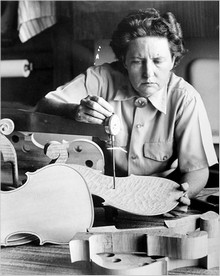Carleen Hutchins
Carleen Hutchins | |
|---|---|
 | |
| Born | May 5, 1911 |
| Died | August 7, 2009 (aged 98) Wolfeboro, New Hampshire, United States |
| Occupation(s) | acoustician, violinmaker and researcher |
Carleen Maley Hutchins (May 24, 1911 – August 7, 2009) was an American high school science teacher, violinmaker and researcher, best known for her creation, in the 1950s/60s, of a family of eight proportionally-sized violins now known as the violin octet (e.g., the vertical viola) and for a considerable body of research into the acoustics of violins. She was born in Springfield, Massachusetts and worked at her home in Montclair, New Jersey.
Hutchins’ greatest innovation, still used by many violinmakers, was a technique known as free-plate tuning. When not attached to a violin, the top and back are called free plates. Her technique gives makers a precise way to refine these plates before a violin is assembled.
From 2002 to 2003, Hutchins’s octet was the subject of an exhibition at the Metropolitan Museum of Art in New York. Titled “The New Violin Family: Augmenting the String Section.” Hutchins was the founder of the New Violin Family Association,[1] creator-in-chief of the Violin Octet, author of more than 100 technical publications, editor of two volumes of collected papers in violin acoustics, four grants from the Martha Baird Rockefeller Fund for Music, recipient of two Guggenheim Fellowships, an Honorary Fellowship from the Acoustical Society of America (ASA), and four honorary doctorates. In 1981, Hutchins also received the ASA Silver Medal in Musical Acoustics.[2] In 1963, Hutchins co-founded the Catgut Acoustical Society, which develops scientific insights into the construction of new and conventional instruments of the violin family.
The Hutchins Consort, named after Hutchins, is a California ensemble featuring all eight instruments.[3]
In 1974, Hutchins and Daniel W. Haines, using materials supplied by the Hercules Materials Company, Inc. (Allegany Ballistics Laboratory) of Cumberland, Maryland, developed a graphite-epoxy composite top that was determined to be a successful alternative to the traditional use of spruce for the violin belly.[4]
In popular culture
[edit]In Cormac McCarthy's novel Stella Maris, the main character, Alicia, talks about corresponding with Hutchins.[5]
References and notes
[edit]- ^ "The Carleen Hutchins Collection and Archive". Retrieved October 22, 2011.
- ^ O’Brien, Elle (2019-11-19). "Carleen Maley Hutchins - Historical Biographies in Acoustics". Acoustics Today. Archived from the original on 2019-12-13. Retrieved 2021-11-28.
- ^ "The Hutchins Consort". Archived from the original on May 26, 2011. Retrieved October 22, 2011.
- ^ "Graphite-Epoxy Violin by Carleen Hutchins". Retrieved September 5, 2021.
- ^ McCarthy, Cormac (2022). Stella Maris. Knopf. p. 120. ISBN 9780307269003.
External links
[edit]- The Carleen Hutchins Collection/Archive
- The Hutchins Consort
- "Carleen Hutchins, Innovative Violin Maker, Is Dead at 98," New York Times, August 8, 2009
Further reading
[edit]American Luthier: Carleen Hutchins—the Art and Science of the Violin by Quincy Whitney, Foredge, 2016, ISBN 978-1611685923
